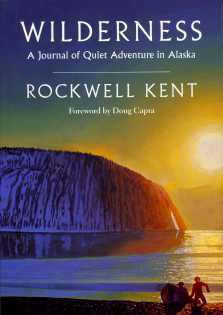|
Wilderness :
a journal of quiet adventure in Alaska / Rockwell Kent ;
foreword by Doug Capra ; including extensive hitherto unpublished
passages from the original journal. - Middletown (Conn.) :
Wesleyan university press, 1996. - XXXIII-203 p. :
ill., map ; 26 cm.
ISBN 0-8195-5293-3
|
BARRY LOPEZ : En 1918, un peintre et illustrateur
américain, Rockwell Kent, arriva sur l'île aux Renards
[Fox island], au large
de la presqu'île de Kenaï (Alaska), avec son fils
de neuf ans, le jeune Rockwell. « Nous sommes venus
sur cette terre, un homme et un enfant, en poursuivant un rêve,
écrivit-il. Ayant eu une vision du Paradis du Nord, nous
sommes venus pour le trouver. » Il voulait dire
qu'il était venu pour arriver à se connaître
et connaître son fils. Il pensait que cette terre
l'aiderait à le faire, et qu'elle prendrait soin
d'eux.
☐ « Rêves
Arctiques », Paris : Union générale
d'éditions (10/18, 2359), 1993 (p. 505)
|
DOUG CAPRA : For seven short months — between
late August 1918 and mid-March 1919 — Rockwell Kent
and his nine-year-old son, also named Rockwell, lived on a small
island in Resurrection Bay not far from Seward, Alaska. Their
host and companion, a seventy-one-year-old Swede and Alaskan
pioneer named Lars Matt Olson, described himself as « noting
bott a broken down Freunters Man ». Lonely, and
too old to prospect and trap as in his youthful days, Olson welcomed
the Kents to his island home, where he ran a small fox and goat
farm.
[…]
☐ Foreword, p. XI
|
From a review by Martha Gruening (april 1920)
THE FREEDOM OF THE WILDERNESS
There is a deep kinship of thought
and feeling between two recent distinctive and beautiful books
of travel 1. Both are the work of men who are primarily
artists in line and colour, who bring to a new medium of expression
an appealing freshness and sincerity that are deeply moving.
Both are the records of men who turned in weariness from the
decadence and ugliness of civilization and found inspiration,
one in the freshness and vigour of an untamed northern wilderness,
the other in the rhythmically beautiful and natural life of the
South Sea islanders.To Rockwell Kent, Fox Island,
Alaska, offered a refuge from the oppression of the « new
freedom, » and he seized upon it eagerly. Unlike Gauguin,
he was at once and wholly in tune with that which he had sought
so confidently. « Having had a vision of a northern
paradise we » (the writer and his nine-year-old son)
« came to find it » and the wilderness
they found, found them ready, joyous and resourceful. They took
it as it was, and the result of their year at Fox Island is the
startlingly beautiful series of drawings reproduced in the text
and the « Journal of Quiet Adventure »
itself, an important event for many reasons but perhaps chiefly
for its unparalleled record of a year of perfect happiness and
freedom in the life of a child.
☐ The Freeman, April 28, 1920 (pp. 165-166)
| 1. | « Wilderness : A journal of quiet adventure in Alaska » by Rockwell
Kent ; « Noa Noa »
by Paul Gauguin [1st U.S. ed.]. |
|
| COMPLÉMENT BIBLIOGRAPHIQUE | | - Herman Melville, « Moby Dick »
ill. by Rockwell Kent, New York : The Modern
library, 2000
| |
|
|
| mise-à-jour : 9 juin 2005 |

| |
|